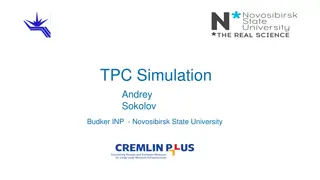Preload Targets and Sequencing for MQXFA03 Assembly and Simulations
Proposal outlines the preload targets for MQXFA03 assembly following a mini-workshop. Plans include radial shim adjustments, pole key clearance options, and azimuthal pre-load targets for optimal coil performance. Paolo Ferracin provides detailed insights into the planned modifications and their expected impact on the overall assembly process.
Download Presentation

Please find below an Image/Link to download the presentation.
The content on the website is provided AS IS for your information and personal use only. It may not be sold, licensed, or shared on other websites without obtaining consent from the author.If you encounter any issues during the download, it is possible that the publisher has removed the file from their server.
You are allowed to download the files provided on this website for personal or commercial use, subject to the condition that they are used lawfully. All files are the property of their respective owners.
The content on the website is provided AS IS for your information and personal use only. It may not be sold, licensed, or shared on other websites without obtaining consent from the author.
E N D
Presentation Transcript
Proposal for MQXFA03 Preload Targets & Preloading Sequence following Mini-workshop on MQXF Assembly, Preload & Simulations Giorgio Ambrosio, Daniel Cheng, Paolo Ferracin, Heng Pan, Soren Prestemon, Eelis Takala, Giorgio Vallone July 1st-2nd, 2019 LBNL logo area
Plans for MQXFA03 Radial shim (see next slide for nominal shim plan) As done in previous short models, the plan is to remove 0.125 mm of radial shim with respect to nominal shim plan This has always been done since LQ to improve coil to collar contact based on Fuji paper results Strain gauge data during bolting of collar pack avoid initial tension in pole strain In MQXFS4 an additional layer of kapton was removed, for a total of 0.250 mm of missing radial shim, since the Fuji paper test was not satisfactory and first loading was showing the LQ effect Paolo Ferracin 2
Nominal Shim Plan Impreg. Radius: 113.376 mm Collar Radius: 114 mm Kapton Shims: 125 m GPI, Kapton: 125 m Paolo Ferracin 3
Plans for MQXFA03 Pole key clearance Two options were considered MQXFS1a case Pole key with fiber in the radial direction high thermal contraction and low modulus A pole key gap per side of ~3 mils This value is larger than in MQXFS1a, where the target was zero gap as a results we expect less force intercepted by the pole key than in MQXFS1a MQXFS4 case Pole key with fiber in the azimuthal direction low thermal contraction and high modulus Key machined to have ~8 mils of pole key gap per side These correspond to the same conditions as MQXFS4 The MQXFS4 case is the selected one Paolo Ferracin 4
Plans for MQXFA03 Azimuthal pre-load (see next slide for summary) The target is MQXFS4, with a reduction of 10 MPa to account for possible larger spread due to the longer length Therefore, target pre-stress at cold is: 100 MPa This means pre-stress at warm of about 80 MPa after creep Assume 5-10 MPa of creep We set as maximum coil stress to 110 MPa during loading Paolo Ferracin 5
Plans for MQXFA03 Axial pre-load (see next slide for summary) The target is MQXFS4, with a reduction of 0.2 MN to limit the rod stress at room temperature and meet the design criteria MQXFA has rods with smaller radius than MQXFB (33 vs 31 mm) Therefore, the total force at cold is: 1.0 MN This means that the total force after cool-down (and at room temperature) will be 0.1 MN higher than in MQXFAP1/P2 Paolo Ferracin 7
Plans for MQXFA03 Pre-load sequence The plan is to adopt the MQXFS4 sequence 1. Coil pack centering (13.1-13.2 mm interference keys) 2. Pre-load axial rods with ~50-100 microstrain 3. 50% azimuthal pre-load (0.250 mm added shim) 4. 50% axial pre-load (about 300 micro-strain) 5. 100% azimuthal pre-load 6. 100% axial pre-load FEM computations indicate lower axial strain in the coil pole during pre-load with this sequence with respect to 100% azimuthal then 100% axial pre- load Further investigation with FE model is in progress Paolo Ferracin 9
Action items Extract the pole keys (fiber in the azimuthal directions) from MQXFA03 coils and machine them in order to have ~8 mils of pole key gap on each side In parallel, continue with shell-yoke sub- assembly Once keys are machined, proceed with coil- pack assembly (no Fuji test) Paolo Ferracin 10























